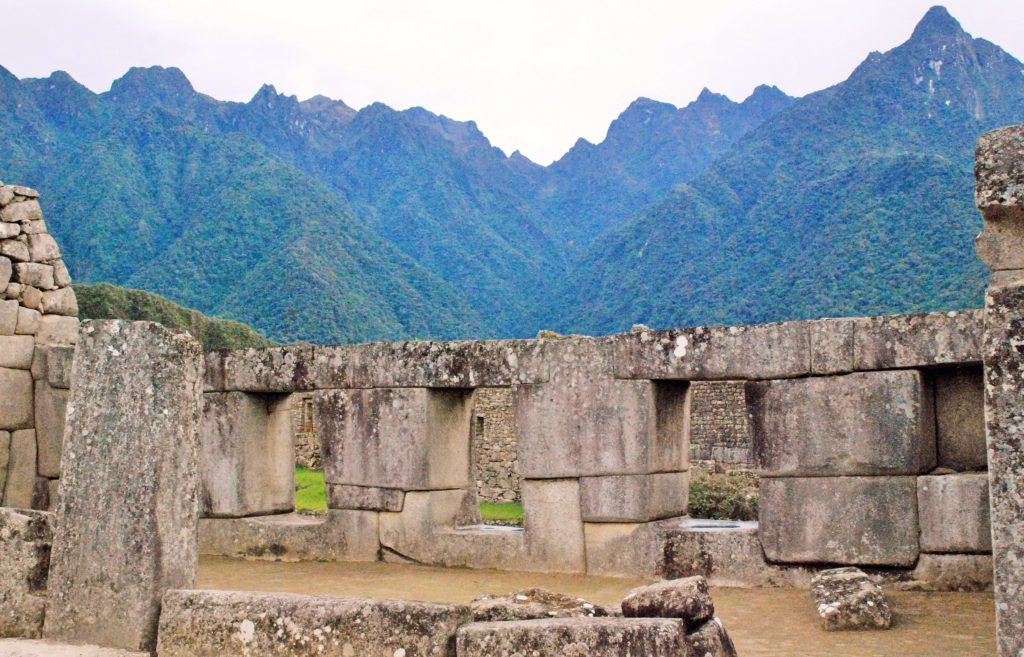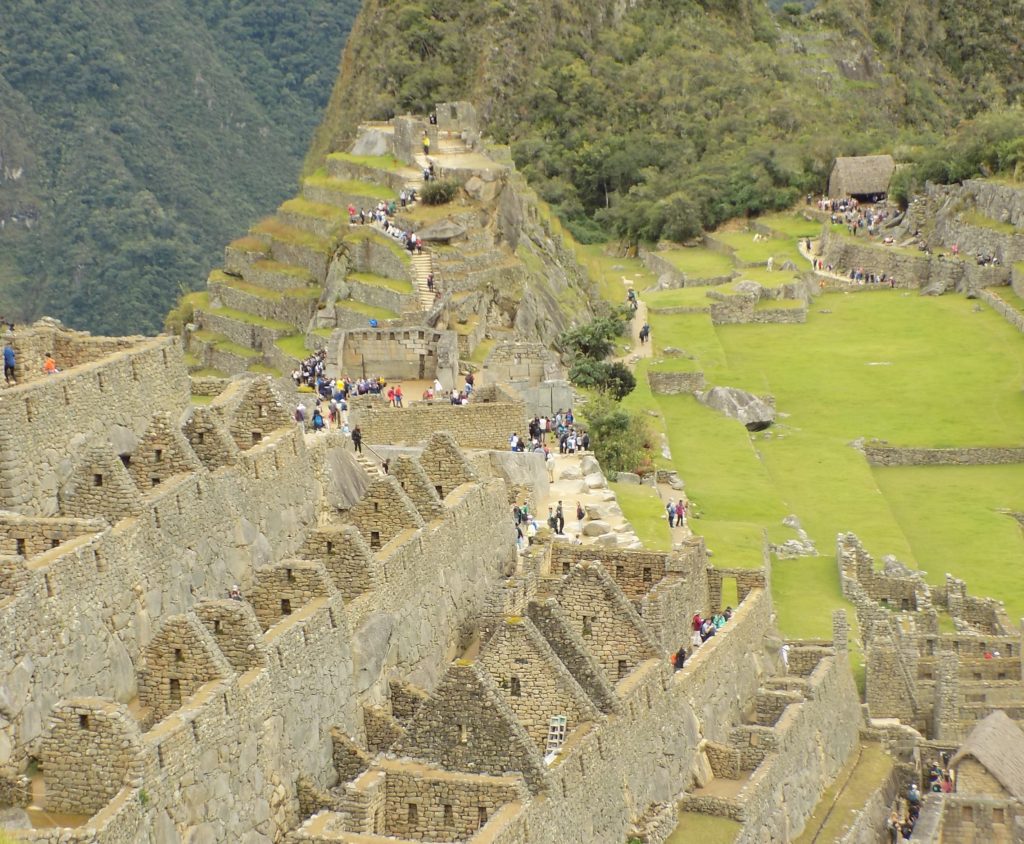It’s time to finish our walk through Machu Picchu. More than merely keeping with the new format of shorter posts, I wanted to allow those of you who are still having some difficulty acclimatizing to the altitude a brief rest. So, now that you’re refreshed, we can leave the Royal Tomb that probably wasn’t and continue with some more of the sacred sites in Machu Picchu. (If you’d like to revisit the photos, this link is to the same album from the previous post.) On a side note, I hope you anticipated the title of this post.
The Sacred Plaza and Main Temple.
The Main Temple occupies a large space in what is generally considered the sacred section of the complex where everything is seemingly arrayed to be a place to worship not just the sun and Inti but light itself.
The side walls of the temple each contain five of the characteristic trapezoidal niches we have seen in other religious structures. They are symmetrical and, although the wall on the right is now lower than its counterpart, they were once set at the same level. The rear wall has seven niches that would have been higher than their counterparts on the side. You should note that a portion of the right side of the wall has partially collapsed. There’s a general belief that while this could have resulted from settlement due to shifting soil, it could also be damage from minor earthquakes.
(Interestingly, atypical openings between rocks and stones at various places in the complex the prompted some geological detective work and, according to researchers from the Cusco-Pata Research Project, those examinations concluded that construction at Machu Picchu was interrupted by an earthquake of at least magnitude 6.5.
They believe that Pachakutiq ordered a halt to the construction and ordered his builders to design catastrophe-resistant architecture. They found that masonry was used to repair the damaged structures and later construction was more cellular. This second phase of construction used more seismic-resistant trapezoidal structures with giant stone blocks at the base and narrower upper walls.
Even with minor damage, it’s held up remarkably well for nearly 700 years.)
The Three Windows Temple.
Just a few meters from the Main Temple on the eastern side of the Sacred Plaza is the building called the Three Windows Temple.
The windows of this rather intriguing lithic structure not only face east but look down to the large grassy expanse called the Main Plaza that’s now maintained by grazing llamas. As with everything else, with no written records to which we can refer, all we can do is speculate regarding the purpose and meaning of the remnants of these buildings. Knowing that Inti, the sun god was among the most important Inkan deities, the set of three large east facing windows impart some significance because it’s among the first places in the complex illuminated by the sunrise over the mountains.
The three openings could, somehow, be representative of the Inkan tripartite vision of the cosmos – Hanan Pacha, Kay Pacha, and Ukhu Pacha. There’s also been some speculation that the three windows allude to the tale of the three Ayar brothers (whom we met at Maras). During his early excavations, Hiram Bingham and his team found shards of smashed pottery beneath the temple floor. They concluded that the pottery was broken as part of some sort of ritual. Thus, it became characterized as a temple. But, the truth is, “We don’t know.”
(As an aside, it’s fun to note that while Bingham gets so much credit for his “discovery”, Agustín Lizárraga, the farmer who assisted him and three of Lizárraga’s fellow farmers and neighbors Gabino Sánchez, Enrique Palma, and Justo Ochoa, etched their names in the windows nearly a decade earlier on 14 July 1902.)
The Intiwatana Pyramid and Stone.
If all of Machu Picchu is mysterious, it may be that the greatest enigma is the stone at the top of the Intiwatana Pyramid. Again, as the Inkas typically did, they fit the structure to suit its surroundings, so the pyramidal shape conforms to the natural contours of the hill on which it sits.
What’s in a name? That which we call the Intiwatana by any other name would remain a mystery. (Intiwatana is usually translated from Quechua to mean ‘place to tie up the sun’. However, two of its component parts – inti meaning ‘sun’ and wata meaning ‘year’ could ascribe a different meaning.)
The pyramid draws its name from the stone that, in addition to any ceremonial and ritual purposes it had, almost certainly served an astronomical purpose. Aspects of its construction and the fact that the stone itself sits not only at the highest point of the Machu Picchu complex but in close proximity to what are believed to be other important ceremonial areas certainly points to its likely importance and to it being both ceremonial and astronomical.
Some local shamanic legends describe one of the rituals allegedly performed here. They say it is a gateway to the spirit world and in one ceremony a person could touch his forehead to a certain spot on the stone and open a vision of this unseen world. There’s also an assertion that the Inkas believed tying the sun to these places prevented it from permanently disappearing.
While ceremonial rituals may have been practiced here and some visitors claim to still feel a spiritual energy at this place, there should be less question regarding its use as an astronomical observatory of sorts. The stone rises at an inclination of approximately 13 degrees. Machu Picchu is at latitude 13.16 degrees south. Thus, on the vernal and autumnal equinoxes it casts no shadow. Similar Inkan stones in the area of Quito, which was part of the empire but is near the equator, are not angled but are rather nearly vertical which indicates not only similar purposes but that the Inkas had sufficient understanding of the earth’s curvature needed to make the adjustment.
This stone has a relation to the solstices as well. Rolf Müller, a German astronomer, found that the two largest sides of the stone are placed so that they are pointed in the direction of sunrise and sunset at the time of the summer and winter solstices.
Broad evidence throughout the Tawantinsuyu shows that astronomy played a central role not only in Inkan culture, religion, and ceremonies, but in their daily lives as well. They used the information as a critical element in planning agricultural activity. At such high altitudes, with relatively predictable rainy and dry seasons, the farmers needed precision in determining the best days to sow their crops and providing such information was one way the leaders could show their wisdom.
Part two of this post completes the walk around Machu Picchu.



